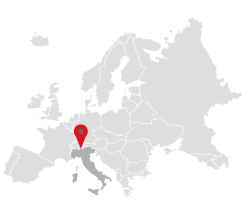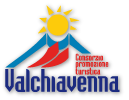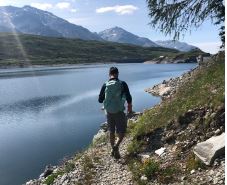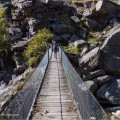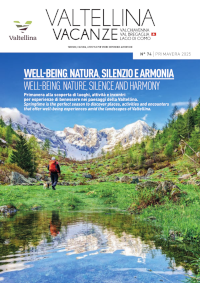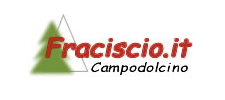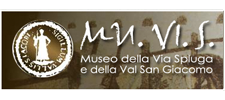The itinerary linking the southern arc of the Alps with Switzerland has always secured a very special place in the hearts of the many who have travelled its length. It has a magic which continues to attract thousands of visitors every year from all over the world.
A unique, historical route indeed. Even within this once-hostile environment traces of human settlements dating back 40,000 years still remain, whilst in the Mesolithic era there is evidence of ancient populations at Pian dei Cavalli, roughly 7,000 years ago.
Man’s presence in the Bronze age is also indicated in the small nucleus of Borghetto, near Isola, and again at Montespluga. And precisely here, in the shadow of the Pass in the Imperial era, the Romans first considered tackling an Alpine crossing, probably around 1 A.D.
Up until the Middle Ages when a single Municipality was established (1205) the local populace had relied on collegiate bodies called “Councils for the Valle di San Giacomo”. Their good fortune was that they represented a less arduous transit option compared with others along the Alpine arc. Nevertheless in order to reach the goal of the Passo Spluga (2,113m) travellers were faced by the considerable challenge of the Cardinello Gorge. It involved a daunting climb from the 1400m of Campodolcino up to the 1908m of Montespluga, by way of a mule-track with its dizzying precipices, once the bottom of the gorge and the Liro torrent had been left behind.
Napoleonic garrisons in 1800 were to lose men by the hundred on the Swiss side of the Alpine pass, plummeting from the hazardous paths, attempting to reach our very own Chiavenna, during the war against the Habsburgs.
Yet throughout the ages, the “Passo Sublime” has attracted some of the most celebrated, and its reputation is well documented: from the Roman general Stilicho, to Otto 1st of Germany; from Leonardo da Vinci to Erasmus of Rotterdam, Wurttemberg to Goethe. And then came the hordes of painters, poets and internationally renowned musicians; writers like Conan Doyle and Hans Christian Andersen. And closer to home: Salvatore Quasimodo, Giovanni Guareschi, Giosuè Carducci.
Intellectuals like Nietsche, Bakunin and Engels all fell under the spell of Vallespluga. Einstein too hung around here. The rock-strewn gorges, winding paths, natural springs, furious torrents, crystal clear lakes, lush green meadows, majestic specimens of tree, snow-capped peaks even in summer, have all combined to make Spluga unique over many a century.
If the Cammino di Santiago represents a fundamentally personal experience, with its wealth of spirituality, then the viaSpluga cries out to be undertaken in company, if only for the respectful nod towards its very particular, harsh environment.
And of course Nature itself abounds. With surprises around every corner. Curious cows grazing on the upper pastures in summer, watching, questioning briefly before returning to more important matters. Goat herds of all shapes and sizes. And donkeys edging close looking for possible treats.
And at the very highest sections the marmot on sentry duty will whistle out your arrival in their very own piece of heaven. By now you will have been adopted, become part of a bigger whole. Part of a history, a glorious past within an arduous territory, proud to have been accepted albeit briefly as you move through a very particular landscape.
On the Swiss side it’s impossible not to gaze upwards towards the Pass itself. A natural, genuine emotion overcomes as you appreciate the ancient path beneath your feet trodden by Europe’s great and good over the centuries, all heading for the magnificent Bel Paese.
It’s not hard to imagine the risks undertaken by intrepid merchants embarking on an ancient route towards Italian ports or indeed those heading north towards the markets of Central Europe.
And it will become evident fairly quickly along the viaSpluga just why so many sensitive souls chose such a challenging yet divine trek in order to appreciate the creativity of Nature itself.
Take the opportunity of all that the re-opening 20 years ago of the viaSpluga in tourist mode offers, and immerse yourself in all its magic: it’s a natural choice which will linger long in the memory.
IN THE FOOTPRINTS LEFT BY THE ROMANS
The viaSpluga is a hiking-cultural trail within the central Alps which over the centuries has united the two towns of Thusis in Switzerland and Chiavenna in Italy.
The route covers around 70 kilometres in all and can be tackled from north to south or vice-versa. The viaSpluga was originally created as a connecting itinerary for the transport of goods on the backs of pack animals. Its twisting mule tracks have been preserved right up to the present day prompting hikers to relive the past along a route largely preserved and indeed restored.
The viaSpluga originated as a consular Roman road, constructed for both military and commercial purposes. It was also known as the via Aurea because it led to the Spluga Pass which the ancient Romans called Cunus Aureus, the “golden point” Following its enlargement at the end of the 1st century B.C. at the behest of Augustus, the route was officially named via Drusilla Augusta in honour of Livia Drusilla, the 3rd wife of the Emperor. In that particular era the itinerary set out from Milan, headed towards Monza, Merate as far as Lecco. From there it skirted the eastern side of Lake Como, connected up with Chiavenna then upwards through the Valle Spluga to the Pass.
For centuries the viaSpluga represented a vital link between Italy and Europe. Pilgrims, wayfarers, merchants and soldiers all travelled its length, often with dread for the danger of some of its sections, in particular that of the Cardinello. The celebrity of the viaSpluga was cut rudely short from 1821 with the opening of Donegani’s magnificent road, sought and financed by the Austrians, and which completely superseded the use of the ancient mule track. The Cardinello remained thus the exclusive domain of shepherds and hunters and was pretty much heading for oblivion. Until that is, on the 28th September 1969, when a group of men, led by Dante Guanella from Campodolcino, set off after more than a century and a half along the route taking in the gorge and moving on foot all the way to Splügen. Nobody could have imagined that just 50 years on the same itinerary would have become one that would be undertaken by thousands of visitors every year from all over the world.
Indeed it was thanks to an interreg project, that in 2000 the viaSpluga was officially re-opened to the public as an organised hiking route. From Thusis (720m) the route takes on the celebrated Viamala gorge as far as Splügen (1457 m). It then heads south climbing to the 2115m, of the Spluga Pass, the highest point along the trail. From here the descent begins, taking in the entire length of the Valle Spluga until reaching Chiavenna at 333m.
Today the viaSpluga represents an important resource for a local economy based on tourism. Thousands of visitors every year tackle this unique, experiential journey; it’s a mode of travelling which encourages you to understand the territory and its evolution, the multiplicity of cultures that populate it and the history of fellow wayfarers treading the very same stones over thousands of years.
